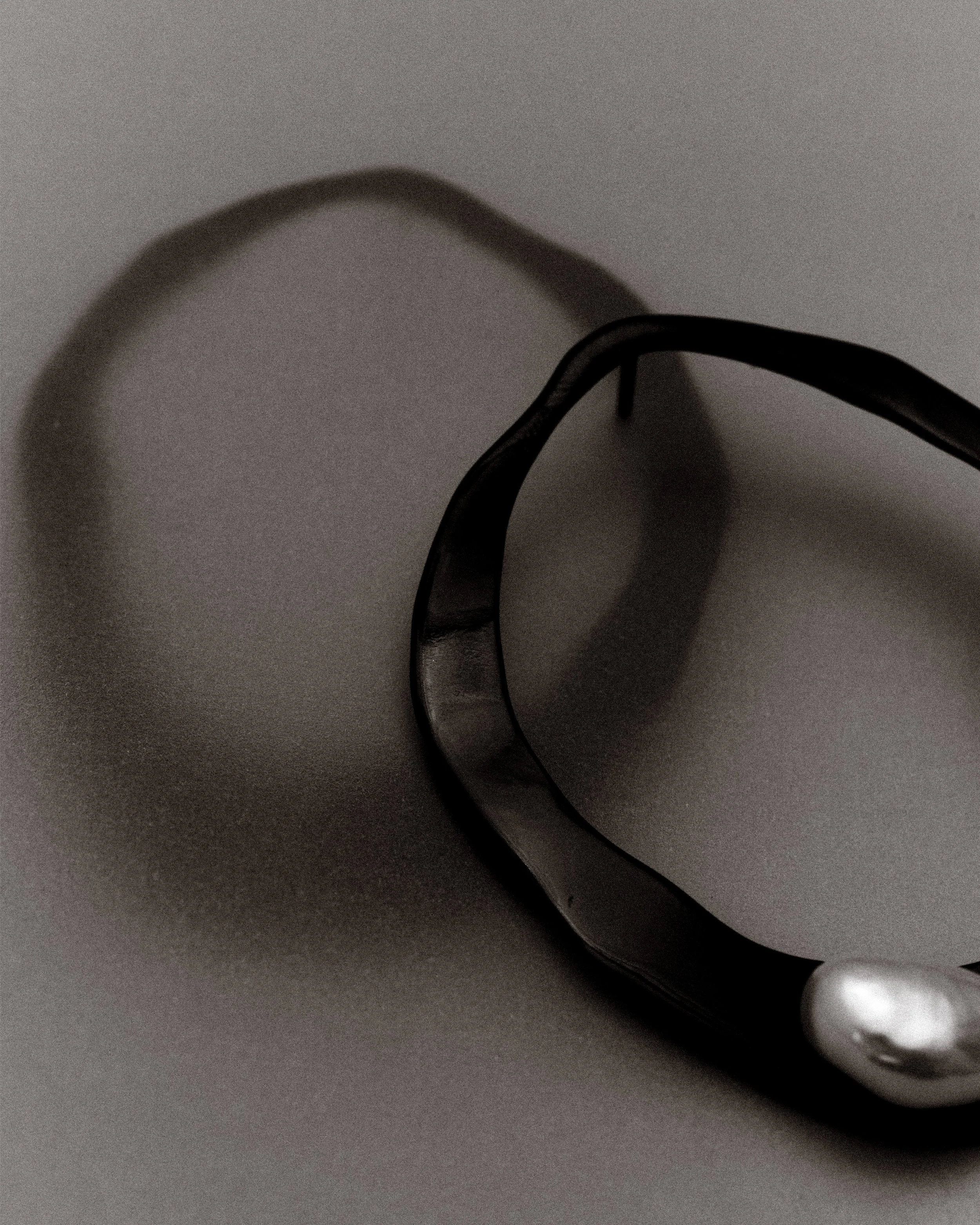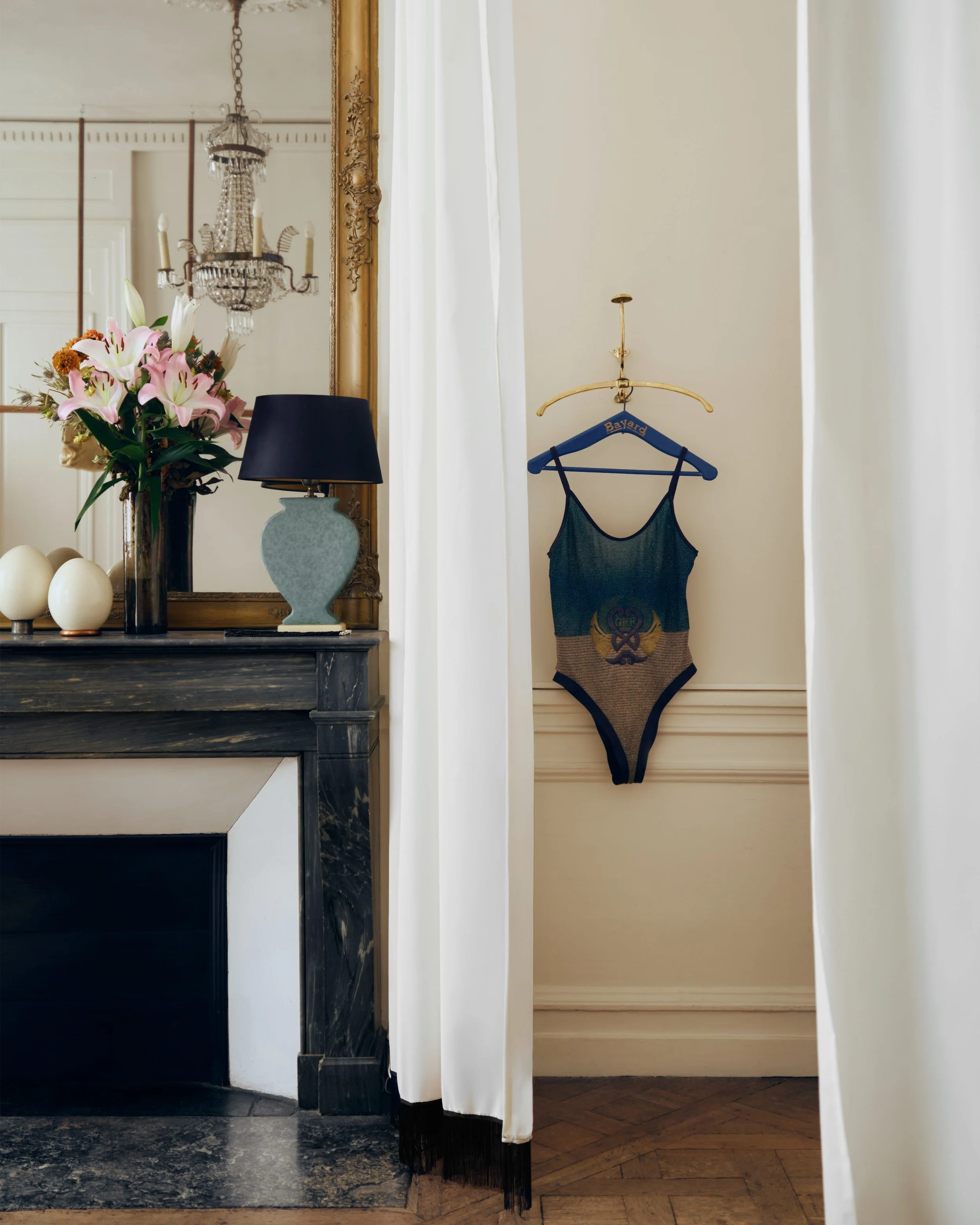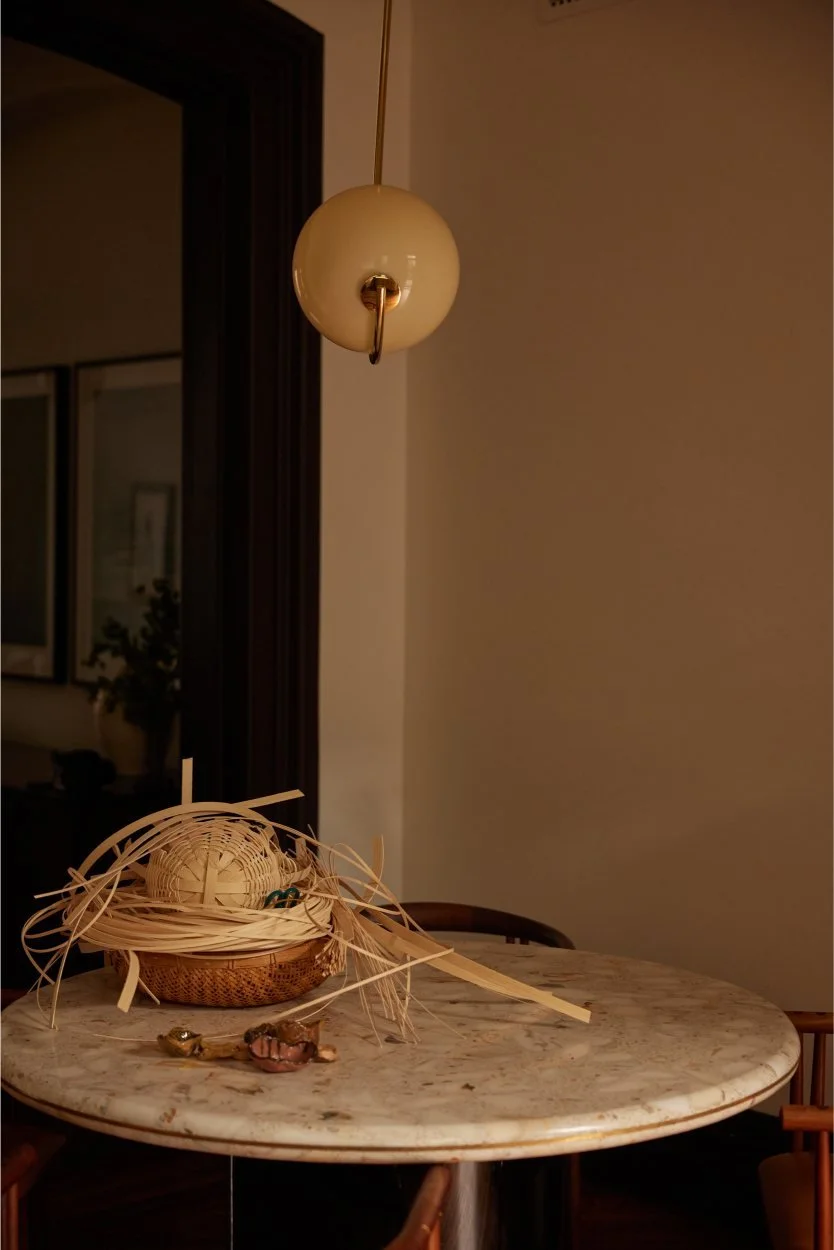Reut
Known for pioneering her patent-pending Black Gold process – a true, enduring deep black finish – Reut redefines fine jewelry through tactile craftsmanship, ethical practices, and a seamless fusion of nature and technology.
We spoke with founder, Reut Ringel on merging artistry and innovation—where hand-sculpted forms, recycled metals, and her patent-pending Black Gold finish meet a new standard of sustainable luxury.
Photography VANESSA GRANDA
Creative Direction & Set Design JOCELYN CABRAL
Interview EMILY PETRUCCIONE
Introduction NICOLE GAVRILLES
BEGINNINGS
What are the origins of Reut? Did you grow up crafting or making things with your hands?
As a child, I was always creating — through music, movement, play, and fashion. Imagination and self-expression were essential to me from a very young age. As an adult in an increasingly digital world, I made a conscious decision to avoid computer-aided design and instead embrace a more tactile, hands-on process. I was drawn to wax sculpting over metalsmithing for its fluidity and ability to capture organic lines. It allows me to shape each piece intuitively, by hand, and to honor the imperfections that arise — imperfections that feel deeply human and alive within the final form.
You did your undergrad at Parsons — how did that experience shape and refine your approach to jewelry?
At Parsons, I studied Strategic Design & Management, where we were taught to lead with systems thinking — sustainability, research, and trend forecasting always came before the actual design process. That shaped how I approach my collections today: material discovery and ethical sourcing are not afterthoughts but the starting point. It also rooted me in the idea of circularity, designing with intention for the full lifecycle of a product.
Who or what were early influences — artists, materials, or techniques — that helped define your distinct aesthetic?
Spending every childhood summer in the Mediterranean deeply shaped my sensibility — the textures, the light, the organic irregularities of the sea and nature. I’ve also been influenced by Japanese design principles, Scandinavian modernism, and minimalist fashion; think the era of Old Céline or The Row’s quiet luxury. These references continue to echo in my work through contrast, balance, and reserved elegance.
Was there a specific moment when you realized your vision could resonate in the broader fine jewelry world?
I began to notice a growing interest in darker metals in my trend forecasting research, such as oxidized silver and rhodium platings and required constant replating. No existing methods truly captured the richness of a deep, saturated black, the results always skewed gunmetal. The obsession with true, enduring black share, and the absence of it in the traditional jewelry world, became the spark for innovation. It made me realize that there was room — and desire — for something entirely new.
CREATIVE VISION
Your pieces are sculptural and distinct. How do you approach your designs, and what usually comes first — concept, material, form, or emotion?
Material always comes first. I begin by sculpting in wax – playing, experimenting, letting imperfections guide the process and embracing them as they arise. Once I have a group of forms, I cast them and curate a selection that feels cohesive: a collection that tells a story. There’s always a dialogue in the work between contrasts: hard and soft, ancient and modernist, organic and engineered. I love reimagining timeless classics through this lens, for example, our Baroque Pearl Drop Earrings which offer a modernist take on an iconic form.
How do you balance staying true to your aesthetic while pushing boundaries in a tradition-bound category like fine jewelry?
For me, pushing boundaries doesn't mean abandoning tradition — it means reinterpreting it. A classic pearl drop earring becomes abstracted through hand-sculpted wax. A traditional gold band becomes modernist through our Black Gold process. I aim to create moments that are delightfully unexpected by introducing high-tech processes to ancient forms or classic silhouettes, breathing new life into a heritage category.
“Material discovery and ethical sourcing are not afterthoughts but the starting point. It also rooted me in the idea of circularity, designing with intention for the full lifecycle of a product.”
Many of your designs carry a story or mood. How do you translate abstract ideas — light/shadow, irregularity, imperfection — into tangible jewelry?
I treat wax as a medium of emotion. I’ll begin with a feeling or visual reference, maybe a texture in nature, a shadow on stone, or a favorite sculpture, and abstract it by hand. The imperfections that arise are never corrected; they’re embraced. This intuitive process allows the piece to evolve organically and carry a mood that is both subtle and sculptural.
BLACK GOLD — INNOVATION & IMPACT
We have to talk about Black Gold — it’s such a remarkable innovation and what drew me to the brand years ago. What inspired you to create a new metal finish rather than working with existing ones?
I’ve always loved wearing black and love its depth and mystery. I wondered why no one was innovating such a traditional sector like fine jewelry, and that everyone never questioned the existence of only three colors – white, yellow, or rose gold. Through noticing oxidized silver and rhodium plated jewelry which result in a gunmetal color, I realized there is a desire for darker metals and set out to invent a rich, true deep black that lasts and is applied more sustainability than traditional wet-bath platings.
Black has always been my personal uniform. It carries depth, mystery, and power. I was surprised that fine jewelry remained confined to white, yellow, and rose gold. When I saw oxidized and rhodium-plated metals attempting a darker look, but only achieving gunmetal, I knew there was a gap, and a desire, for something deeper and richer. That was the beginning of the journey to create Black Gold.
Can you walk us through the research, experimentation, and challenges that led to your patent-pending Black Gold process?
When I couldn’t find the treatment I envisioned in terms of color and longevity within the jewelry world, I started researching outside it, looking into industrial fields like aerospace, automotive, and medical tooling. After extensive experimentation, we developed our own proprietary multi-step process that achieves a deep, true black with durability and sustainability in mind. It’s now patent-pending and exclusive to Reut.
“I aim to create moments that are delightfully unexpected by introducing high-tech processes to ancient forms or classic silhouettes, breathing new life into a heritage category.”
How does Black Gold behave differently in the studio compared to traditional metals, and how does that influence your designs? Does it communicate something other materials can’t?
It requires us to think ahead. For example, in pieces with pearls which are delicate and cannot undergo the process, the design must accommodate adding them as a final step. I love that juxtaposition: the metal goes through this high-tech transformation, then is finished by hand with something organic, raw, and imperfect like the baroque pearl. It reflects the ethos of the brand — a union of innovation and nature.
How do you envision this material evolving in future collections — or even beyond jewelry?
Black is just the beginning — a canvas. I see future collections exploring color in unexpected ways, using similar high-tech methods to create tones that feel elemental yet contemporary. I’m also excited about potential collaborations to apply the process beyond jewelry — into design, homewares, fashion, or even architecture.
You mentioned that if someone wants to remove the Black Gold finish, it remains solid gold. Such a cool factor to keep in mind as a customer. Can you speak more to that?
Absolutely. Designing with a circular mindset is essential, especially when working with precious materials. Our Black Gold treatment is durable, but reversible, giving the customer long-term flexibility on their investment. Whether they want to keep it as-is or return to its original gold state decades from now, the integrity of the material remains.
CRAFTSMANSHIP, MATERIALS & SUSTAINABILITY
How do you select your materials, especially when experimenting with unconventional ones? Are aesthetic, ethical, durability, and sustainability all factors?
Everything begins with purpose. Materials must meet our standards of durability, sustainability, and aesthetics but also tell a story. I see each piece as a wearable sculpture. We use recycled metals, work with local artisans, and treat every decision, even down to the finishing process, as part of the narrative of contrast and duality that defines the brand.
Reut emphasizes zero-waste and made-to-order practices. How do these principles shape your process?
They allow us to be intentional. Working made-to-order means we're not overproducing — every piece has a purpose and a home. We use recycled metals and maintain a tight loop on waste and excess. Even our proprietary Black Gold process incorporates zero-waste methodology, which produces no chemical byproduct, unlike traditional plating techniques such as electroplating. It is part of our commitment to creating fine jewelry that is both beautiful and responsible — not just in form, but in process.
How do you work with local artisans, and what are the rewards and challenges of keeping production local in NYC?
Working locally in New York allows us to build personal relationships with our artisans to ensure ethical working conditions and maintain a close eye on quality. It also supports the local economy and preserves craftsmanship in a city we love. Of course, producing here is not the cheapest path, but for us the transparency and connection to our supply chain outweigh the challenges.
“Our Black Gold treatment is durable, but reversible, giving the customer long-term flexibility on their investment.”
OUTLOOK
Looking ahead, what excites you most about the future of Reut — new materials, techniques, or collections? And what about the present lights you up most?
I am excited about the possibility to apply our innovative process to various possible products through collaborations, and to explore new exclusive colorways through collaborations.
I’m excited to keep innovating. To push the boundaries of what’s possible in fine jewelry and beyond, through new materials and collaborations. Exploring exclusive colorways is a natural next step, and I’m looking forward to seeing how our process might expand beyond jewelry into other creative disciplines. In the present, I’m energized by people’s emotional reaction to Black Gold, the stories our collection tells, and the community we’re beginning to build.
Any advice to give emerging designers trying to balance innovation, craftsmanship, and sustainability?
Start with purpose, not just product. When your work is rooted in meaning, the balance between innovation, sustainability, and craftsmanship comes more naturally. Be curious even about industries that have nothing to do with your own. Quality over quantity, always. And remember: limitations often lead to your most creative breakthroughs.
Reut is a fine jewelry house based in New York City, blending innovation with traditional craftsmanship to explore the intersection of art, technology, and sustainability. Founded by Reut Ringel, a Parsons The New School of Design graduate, the collection is centered around a distinctive approach to design, merging sculptural elements and ancient techniques with new materials and innovation. Reut introduced the world’s first permanent Black Gold through a patent-pending process that challenges conventional norms in the fine jewelry industry.
For more information about Reut, visit their website.
YOU MIGHT ALSO LIKE



















We spoke with founder Erika Geraerts about her mission to challenge conventional beauty narratives through thoughtful design, transparent storytelling, and fewer-but-better products.